MSI GT72 Dominator Pro: Performance Preview
by Jarred Walton on October 8, 2014 9:00 AM ESTMSI GT72: Ultra Quality Gaming Performance
Okay, that's enough small talk. I know most of you are really only interested in one thing: how fast is the GTX 980M? I've run a limited set of benchmarks on the system, basically testing at 1920x1080p "Ultra" and "High" settings. I've also increased the number of games being tested for this article beyond the usual five that we use for notebooks, simply because this is first and foremost a gaming notebook. PCMark and general system performance results might be nice to know, but I don't think anyone is going to buy the GT72 unless they plan on utilizing that shiny new GTX 980M. The new games are Batman: Arkham Origins, GRID Autosport, Metro: Last Light Redux, and Sniper Elite 3; I've also brought back Company of Heroes 2, which isn't something we normally test on notebooks. For now I'm comparing the GT72 with three other MSI notebook, and I've also tossed in a desktop i7-4770K (at 4.1GHz) with a GTX 970 as a reference; in theory, the GTX 980M shouldn't be too far off the GTX 970 performance.
For the sake of completeness, the settings used for Ultra generally include anti-aliasing, and in some cases that means SSAA (which can really pummel the GPU). Batman: Arkham Origins sets all the options to on/DX11, anti-aliasing is 4xMSAA, and PhysX is disabled. BioShock Infinite uses the UltraDX11_DDOF setting, Company of Heroes 2 has all the options at their maximum (including anti-aliasing set to High), and GRID Autosport has 4xMSAA enabled with the Ultra quality preset. For Metro: Last Light Redux, all settings are at maximum (including SSAA). And wrapping up, Sleeping Dogs uses the Extreme preset (which includes High SSAA), Sniper Elite 3 uses the Ultra preset with 4xSSAA enabled, and Tomb Raider uses the Ultimate preset (but without enabling SSAA – maxing out the settings drops the 980M by 7 FPS if you're wondering, so it's not a huge difference). Here are the benchmark results, starting with Ultra quality:
1920x1080 Ultra Performance
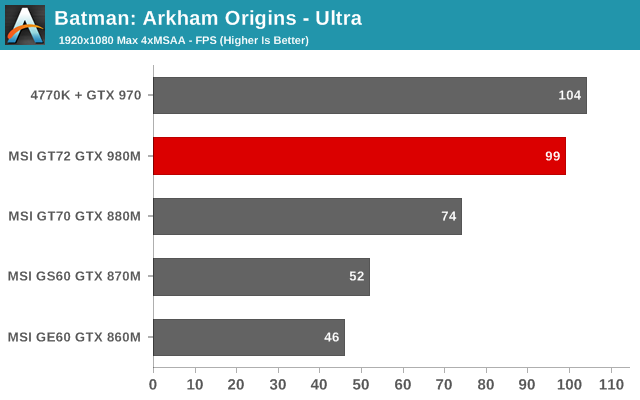
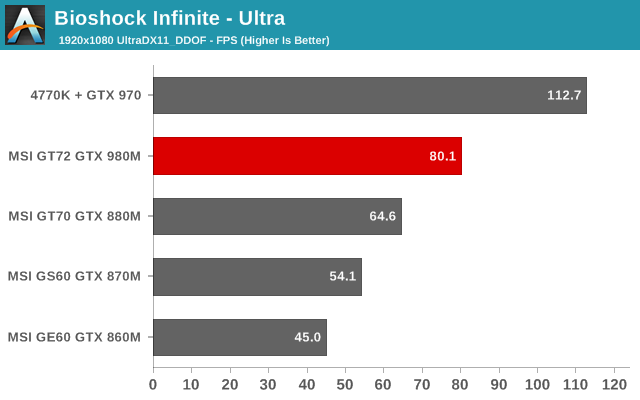

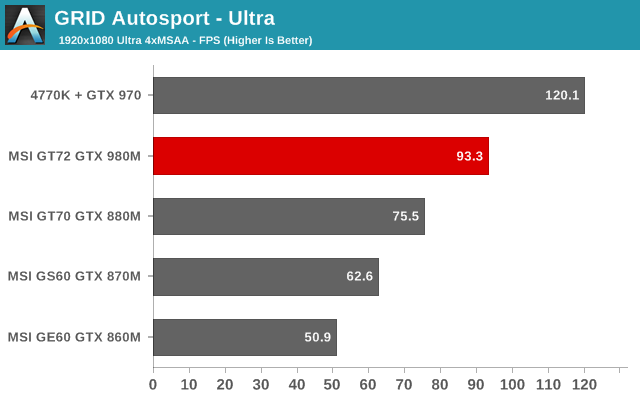
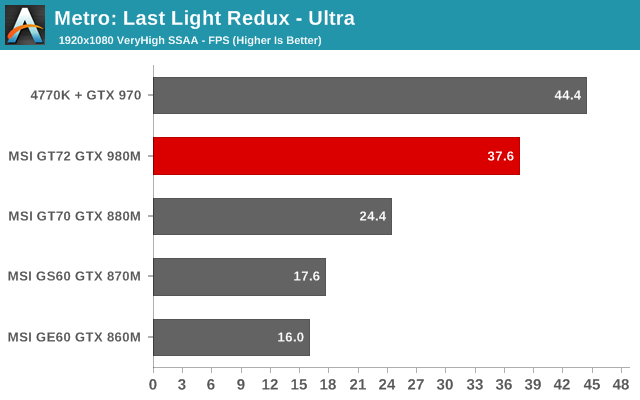
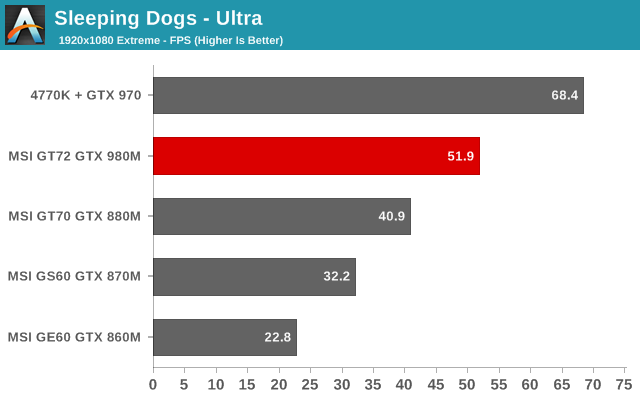
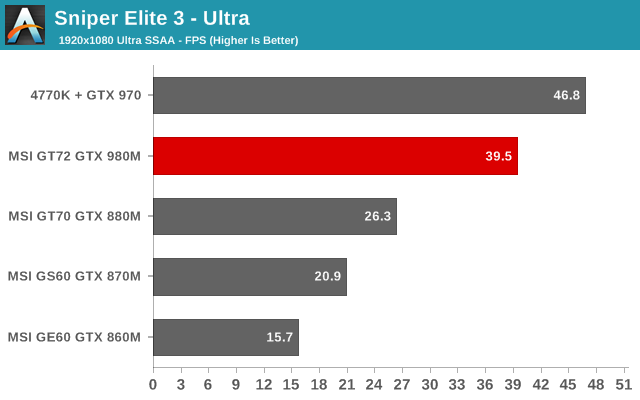
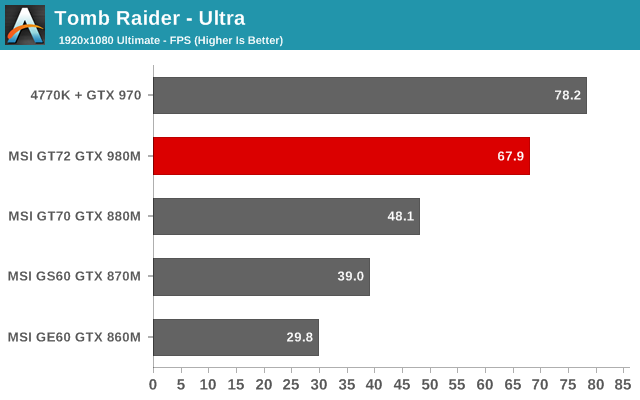
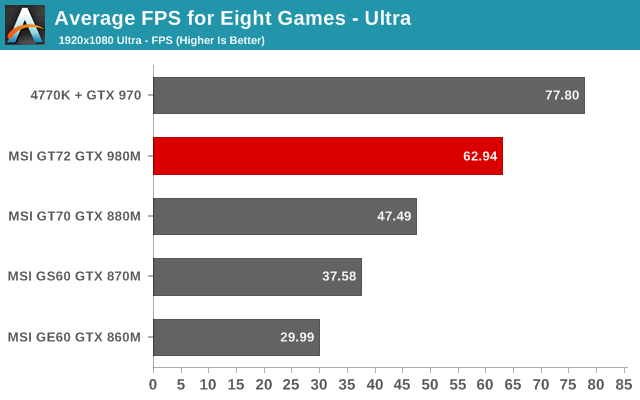
First, let me just say that the inclusion of the desktop GTX 970 is really something of a high water mark for mobile GPUs to strive for. Granted, it's a $329 part compared to a $2200+ notebook, but high-end gaming notebooks have never been particularly economical. The fact that the GTX 980M can come close to the GTX 970 is pretty impressive, and it also breaks 30FPS in every one of our test games – something no other mobile GPU has ever achieved.
Obviously there are still going to be games where cranking every dial up to 11 isn't going to work out so well. Metro: Last Light (and the Redux sequel) is a prime example of this, as enabling SSAA in particular can bring even the fastest desktop GPUs down to unplayable frame rates; games like Crysis 3 and The Witcher 2 can be similarly taxing with all the settings maxed. Of course, if we're talking about "normal" settings (e.g. not SSAA), the GTX 980M is able to handle pretty much anything you might want to throw at it. Dropping down to our High settings (which mostly means turning off anti-aliasing in terms of quality and performance, though there are also differences between High and Very High/Ultra in some titles), performance jumps well into the playable range.
In terms of average performance, the GTX 980M tops all mobile contenders by a sizeable margin. It's about 35% faster than the GTX 880M, 70% faster than GTX 870M, and a whopping 110% faster than GTX 860M. Interestingly, I was expecting performance to be closer to the desktop GTX 970, but it turns out the 980M only manages to deliver 81% of the 970 performance on average. GPU memory bandwidth may be a factor here (7GHz vs. 5GHz), and the desktop GPU is also being helped by a CPU that's clocked 17-28% higher than the i7-4710HQ (depending on how high the 4710HQ is able to turbo).
This is part of what makes me wonder if MSI went a bit too conservative on the CPU side of things, but then we're already pushing high frame rates with the 4710HQ and in most cases it's only going to be frame rates above 60 FPS where the CPU plays a significant role.










53 Comments
View All Comments
JarredWalton - Wednesday, October 8, 2014 - link
Older than that: This is Spinal Tap (http://en.wikipedia.org/wiki/Up_to_eleven)"As you can see, these numbers all go up to eleven. That's one louder than ten...." :-)
WereCatf - Wednesday, October 8, 2014 - link
Every time someone reviews these gaming laptops I wonder one thing: where are the laptops that are designed not to have an optical drive at all? I mean, you could certainly just leave the ODD out, but the chassis would still be designed with one in mind. What if I want a laptop with chassis that was not designed to hold an ODD at all and instead used the space for, say, better cooling?sullrosh - Wednesday, October 8, 2014 - link
just make the ODD removable and design an extra battery to fit in the slot.WereCatf - Thursday, October 9, 2014 - link
No. You'd still be wasting space on the support structures -- connectors and rails and whatnot -- plus the casing on the extra battery itself. It'd be more efficient to just skip the ODD-bay completely and simply make the main battery itself larger. Personally, when talking of gaming laptops I want good cooling-performance and skipping the ODD-bay would allow for designing airflow properly so that cool air goes in from one side and blows out the other side, all through the whole laptop. That's what I want, real, proper cooling in a gaming-laptop, without the totally useless ODD-bay at all.danjw - Wednesday, October 8, 2014 - link
What is going on with Broadwell. I was just looking around for a current time frame and all I saw was the Core M parts for tablets. Has Intel given up on Broadwell for more powerful systems?Acarney - Wednesday, October 8, 2014 - link
Is there anyway to get these graphic cards standalone? Was there any upgrade path in the retail chain? What's the connector for these and has there been any kind of hacked/modded cables for connecting these graphic cards to desktop motherboards? I think the potential for cooking this in a passive card (think HDplex) is higher then taking a desktop class board and trying to cool that. I know HDPlex has a new chassis about to be released that'll handle a 750Ti Maxwell part but this might be able to handle a 970M (if the rumored ~95w TDP is true and MAYBE even the 980M with a semi passive option; think one or two ~15dBa fans to move some air out of the chassis). Both these cards seem to out perform the 750Ti and probably would do even a little better matched with a desktop class i7 haswell. Could finally match or exceed Xbox1/PS4 class graphics with a box including the 970M or 980M & 100% passive for HTPC/DVR and ~15dBa semi passive when 1080p gaming...Laststop311 - Thursday, October 9, 2014 - link
Well When I upgraded my m18x r1 from radeon 6990 xfire to gtx 680m sli I ordered the gpu's from dell. You can buy the parts separately but they are not cheap at all. I paid 700 dollars each for my GTX 680m's when they first came out.The TDP claims are true and you need a MXM slot to install these dpu's they dont go into a regular pci-e slot but the tdp claims have tpo be true as MXM slots only provide for a max of 100 watt tdp.
For this project idea you have be prepared to spend around 3000 when all is said and done and that's if you can even locate all the parts you would need. You would need to find a motherboard that supports desktop cpu's and MXM graphics cards. Like the boards used in some laptops that use full desktop cpu's. That specialized board will cost you big bucks. They use all laptop parts like so-dimms and mxm gpu's but have a regular desktop cpu socket. I believe clevo made laptops like this. The GTX 980m will probably cost 1000 dollars to buy as a standalone separate part from dell or such. So by the time you buy a proper case, the specialized mobo, the gpu, sodimm ram, tiny psu, cpu, storage, odd and whatever else you may be looking at even more than 3000. Is it really worth it just to have a silent htpc with extra potent gaming power?
You do realize you can build a very quiet htpc with MSI gaming gtx 970 gpu and that fans don't even start spinning until the gpu hits 60C so when you are doing anything other than gaming the gpu fans don't come on and then even under light gaming it can turn on just 1 of the 2 fans and since it uses large 100mm fans they spin much slower. Check out the reviews the twin frozr V cooling system with 2x 100mm fans it is literally the quietest top end GPU ever. Even the GTX 980 is super quiet like 1db louder than gtx 970. And really since the fans don't even turn on except for gaming you have the silence you are looking for when you actually need it. You don't need pure silence when you are gaming as the noise from the gaming will far drown out the tiny fan noise. When you are watching movies or doing anything else you have silence.
You can build this version of what you want far cheaper then trying to build this laptop gpu version. 100 dollar mitx board, 350 dollar gpu, 250 dollar cpu, 100 dollar ram, 75 dollar psu, 100 dollar case, 20 dollar ODD, storage varies depending on how much space you need but since you can use 2.5" drives pretty dirt cheap 230 dollars for 512GB or so. Add another 200 for top quality noctua case fans that are dead silent and a noctua cpu cooler with noctua heatsink fans that are also dead silent and you spend 1400 for something you are going to spend 3000 on doing it the convoluted way you describe. You can send me 800 dollars as a consultation fee and still be 800 cheaper
Laststop311 - Thursday, October 9, 2014 - link
when i say large 100mm fans i mean relatively large as fans located on the gpu are typically 80mm or even smaller. 100mm size on the actual gpu is the largest size to date to come pre installed on a gpu.rpanic - Wednesday, October 8, 2014 - link
Got a MSI 17” barebones with 680m a few years ago, travel with it and have it on every day very happy with it and it was cheaper than anything else when the 680m came out. Very solid laptop if you don’t mind putting in your own OS, HD and CPU.jdrch - Wednesday, October 8, 2014 - link
With 2 mDP 1.2, an HDMI, and a GigE port, this thing is pretty much a dream engineering workstation. Compare that with HP's EliteBook line that has 1 DP port, or Dell's Precision line that has 1 DP and 1 HDMI.